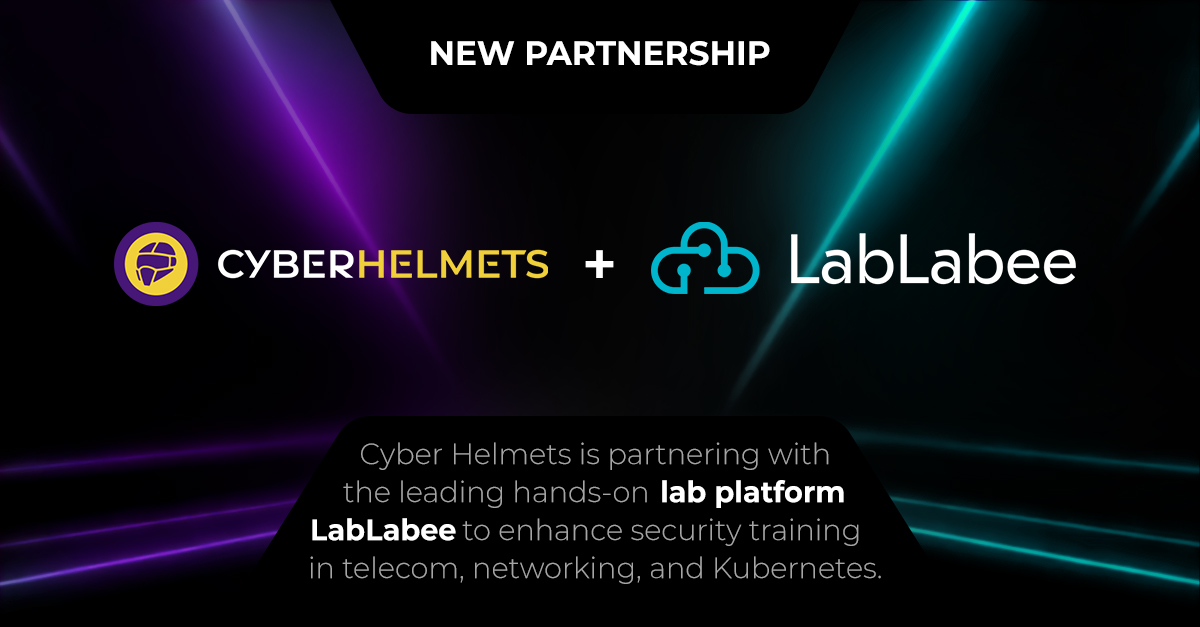The telecommunications industry stands at a critical juncture where the convergence of 5G networks and containerized infrastructure creates unprecedented security challenges. LabLabee, a leading provider of hands-on telecom cloud training labs, and Cyber Helmets, a cybersecurity training provider specializing in custom-built training programs, are uniquely positioned to address this market gap through a strategic partnership focused on 5G Kubernetes security training. This collaboration represents the industry’s first comprehensive program combining real-world 5G network scenarios with advanced cybersecurity defense strategies, directly addressing the critical skills shortage in securing containerized telecommunications infrastructure.
Why now: The urgent demand for 5G Kubernetes security training.
Cybersecurity training is booming and telecom is leading the charge
The cybersecurity training industry is in the middle of an explosive growth phase. Forecasts show the global market rising from $4.53 billion in 2023 to nearly $15 billion by 2031 a staggering 16.8% CAGR. And it’s not just general enterprise demand that’s driving it. The IT & Telecom sector leads the way, commanding more than 24% of the market share.
Why? Because as 5G becomes the core infrastructure for everything from national defense to autonomous mobility, the need for domain-specific security skills especially in containerized and cloud-native environments is rapidly outpacing supply.
5G infrastructure is a growing attack surface
It’s no longer theoretical. Recent research uncovered over 100 vulnerabilities in LTE and 5G implementations, capable of disrupting cellular communications at a city-wide scale. The shift to cloud-native architectures (especially those relying on Kubernetes for orchestration) introduces even more complexity, more entry points, and more room for error.
From unauthorized access and IoT compromise to supply chain infiltration and lateral movement across network functions, attackers are taking advantage of every inch of this new terrain.
This isn’t just a matter of patching software, it’s about building expertise across telecom-specific threat models, container security, and live defense strategy.
An alarming skills gap in telecom cybersecurity
The telecom industry is feeling the pressure. There is a critical talent shortage at the intersection of telecom engineering and cybersecurity—a gap that becomes painfully obvious as providers transition to Kubernetes-managed, cloud-native 5G cores.
Traditional cybersecurity training doesn’t cover telecom realities. And conventional telecom education doesn’t cover offensive or defensive security. What’s needed is a hybrid skillset: professionals who understand both the infrastructure of 5G and the cyber threats that target it.
This is the exact gap the Cyber Helmets × LabLabee partnership is designed to close training professionals to meet the real-world demands of securing tomorrow’s digital backbone.
Partnership in action: Where telecom meets cyber defense.
Aligning expertise for maximum impact
At the core of this strategic partnership lies a shared belief: that real-world challenges require real-world training. LabLabee, a pioneer in hands-on telecom cloud training, brings its cutting-edge, hardware-free lab environments designed for rapid onboarding and upskilling in 5G and cloud-native infrastructure. Their platform is trusted by leading telecom players and academic institutions alike for preparing teams to thrive in a rapidly evolving network landscape.
Cyber Helmets complements this with deep cybersecurity expertise, specifically in offensive and defensive tactics across cloud-native environments. Our training philosophy goes beyond theoretical learning. We build cybersecurity proficiency through expert-led, lab-driven scenarios tailored to real operational risks and threats.
Together, this partnership creates a seamless bridge between telecom infrastructure and security operations, something the industry critically lacks today.
Training designed for real-world 5G security
This isn’t just another certification course. We’re building fully interactive training labs that replicate real-world 5G deployments running on Kubernetes complete with multi-vendor network functions, simulated traffic flows, and dynamic security zones.
Trainees will step into the shoes of defenders (and attackers), gaining hands-on experience securing critical workloads, enforcing access controls, and detecting persistent threats across a live 5G Kubernetes stack. Every exercise is purpose-built to reflect today’s most pressing threats and tomorrow’s regulatory standards, from 3GPP security architecture to GSMA compliance.
Curriculum built for the next decade of 5G
We’ve structured the curriculum around five pillars that reflect the most urgent challenges telecom teams face today:
-
5G network security fundamentals
-
Kubernetes security in telecom environments
-
Container orchestration threat modeling
-
Advanced persistent threat detection in 5G networks
-
Incident response for containerized network functions
This isn’t about generic cloud training. It’s a focused, high-fidelity simulation of what it actually takes to defend next-gen networks.
With this partnership, Cyber Helmets and LabLabee are setting a new bar for telecom security readiness combining domain-specific realism with elite cybersecurity training to help teams build resilience where it matters most.
Training that works like the real world
Cloud-native labs — No hardware, ho hassle
One of the key innovations behind this partnership is accessibility without compromise. LabLabee’s cloud-based, hardware-free training environments remove the cost and complexity of physical setups. Trainees can launch fully interactive 5G network labs instantly anytime, anywhere.
But this isn’t just simulated theory. These environments are being infused with Cyber Helmets’ real-world attack simulations and defense playbooks, tailored specifically to Kubernetes-driven 5G infrastructures. Every lab session becomes a live-fire exercise in defending the networks that underpin modern society.
Security by design, not as an afterthought
This program is built on a security-first foundation focused on the actual pain points that service providers face in the field. From multi-tenancy risks and workload isolation to virtualization security and container hardening, participants are immersed in the technical realities of securing complex telecom stacks.
Hands-on labs will cover just the tools and tactics needed to protect containerized 5G networks in production:
-
Identity and access management (IAM)
-
Network segmentation and zero-trust design
-
Vulnerability scanning & remediation
-
Configuration management in distributed 5G environments
Certifications that mean business
The end goal? To produce professionals who are immediately deployable in high-stakes environments. That’s why the partnership is introducing industry-aligned certification pathways that combine telecom domain knowledge with hands-on cybersecurity expertise.
These certifications are engineered for Kubernetes-based 5G deployments, aligning with global standards and compliance mandates from bodies like 3GPP, GSMA, and leading security frameworks. For telecoms, MSSPs, or government agencies seeking proven talent, these credentials will stand out as a mark of operational readiness.
Strategic impact: Solving the industry’s most pressing security challenge
Meeting the market where it hurts most
This partnership couldn’t be more timely. As 5G becomes the spinal cord of critical infrastructure, from defense systems to emergency services, telecom operators face mounting pressure to deploy secure, cloud-native networks at scale. Kubernetes is now central to 5G orchestration, but with this shift comes a wave of new attack surfaces, misconfiguration risks, and compliance challenges.
And yet, the industry faces a major talent shortfall. Few professionals have deep expertise in both telecom operations and cybersecurity defense. The Cyber Helmets × LabLabee initiative tackles this problem head-on, delivering a program designed to build cross-functional capabilities that no existing curriculum currently provides.
A first-of-its-kind advantage
This isn’t just another cyber course or a generic telecom certification. It’s the first training program laser-focused on 5G Kubernetes security, giving both companies a clear edge in two high-growth markets:
-
LabLabee extends its leadership in telecom training into the red-hot cybersecurity domain, offering partners and clients a future-ready learning solution.
-
Cyber Helmets gains deep integration with telecom infrastructure, opening new strategic relationships and extending its portfolio into one of the most security-critical verticals on the planet.
Together, the partnership sets a new standard for what industry-aligned, cross-domain training should look like practical, scalable, and purpose-built for the networks that run the world.
A partnership built for what’s next
The collaboration between LabLabee and Cyber Helmets isn’t just timely, it’s transformational. By merging LabLabee’s deep expertise in hands-on 5G telecom training with Cyber Helmets’ track record in advanced cybersecurity education, this partnership delivers something the industry desperately needs: a way to build real, cross-functional talent that can defend the world’s most critical infrastructure.
This initiative directly addresses today’s skill shortages, tomorrow’s threat landscape, and the growing complexity of cloud-native 5G networks. But more than that, it lays the groundwork for continuous innovation empowering organizations and professionals to secure the next generation of global communications.
As 5G and Kubernetes redefine how networks operate, LabLabee × Cyber Helmets is redefining how they’re secured.
Stay tuned for the launch of our joint training program bringing 5G Kubernetes security training to the professionals who need it most.














